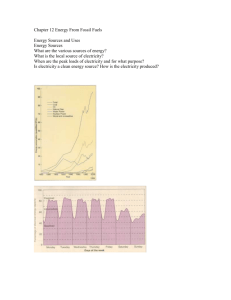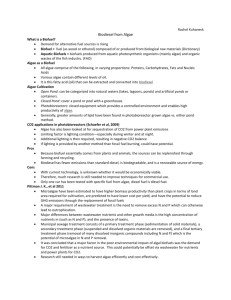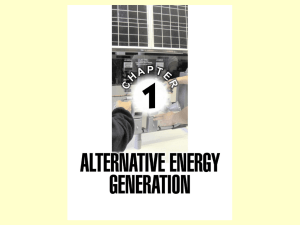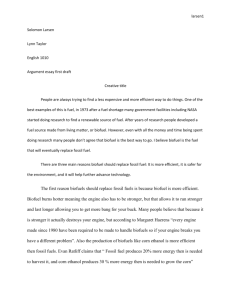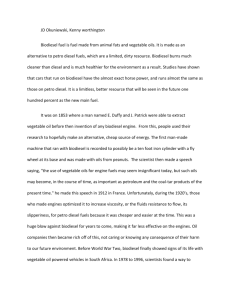Algae to Biofuels Kids Vocab
advertisement
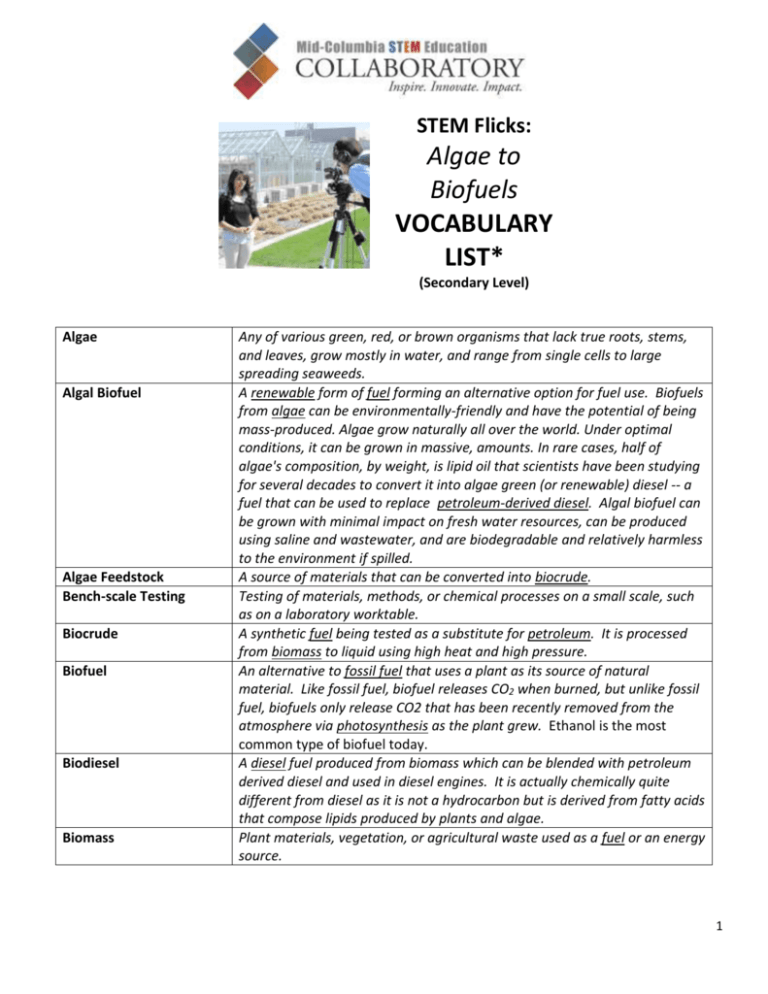
STEM Flicks: Algae to Biofuels VOCABULARY LIST* (Secondary Level) Algae Algal Biofuel Algae Feedstock Bench-scale Testing Biocrude Biofuel Biodiesel Biomass Any of various green, red, or brown organisms that lack true roots, stems, and leaves, grow mostly in water, and range from single cells to large spreading seaweeds. A renewable form of fuel forming an alternative option for fuel use. Biofuels from algae can be environmentally-friendly and have the potential of being mass-produced. Algae grow naturally all over the world. Under optimal conditions, it can be grown in massive, amounts. In rare cases, half of algae's composition, by weight, is lipid oil that scientists have been studying for several decades to convert it into algae green (or renewable) diesel -- a fuel that can be used to replace petroleum-derived diesel. Algal biofuel can be grown with minimal impact on fresh water resources, can be produced using saline and wastewater, and are biodegradable and relatively harmless to the environment if spilled. A source of materials that can be converted into biocrude. Testing of materials, methods, or chemical processes on a small scale, such as on a laboratory worktable. A synthetic fuel being tested as a substitute for petroleum. It is processed from biomass to liquid using high heat and high pressure. An alternative to fossil fuel that uses a plant as its source of natural material. Like fossil fuel, biofuel releases CO2 when burned, but unlike fossil fuel, biofuels only release CO2 that has been recently removed from the atmosphere via photosynthesis as the plant grew. Ethanol is the most common type of biofuel today. A diesel fuel produced from biomass which can be blended with petroleum derived diesel and used in diesel engines. It is actually chemically quite different from diesel as it is not a hydrocarbon but is derived from fatty acids that compose lipids produced by plants and algae. Plant materials, vegetation, or agricultural waste used as a fuel or an energy source. 1 Carbon Dioxide Conversion Diesel Feedstock First Generation Biofuels Fossil Fuels Fuel Gasoline Global Climate Greenhouse Gas (GHG) High Pressure Temperature Tubular Reactor Hydrocarbon Fossil Fuels Hydrothermal Liquefaction Hydrocarbons Industrial Scale Multi-disciplinary Team Nonrenewable Resource Nutrients A colorless, odorless gas that does not burn, is composed of carbon and oxygen in the proportion one C and two O and is present in the atmosphere or formed when any fuel containing carbon is burned. It is exhaled from an animal’s lungs during respiration and is used by plants in photosynthesis. The act of changing one thing, use, or purpose into another. A type of fuel, derived from fossil fuels, that is used in a diesel engine. A raw material for processing or manufacturing industry. A fuel that was derived from sources like starch, sugar, animal fats and vegetable oil. A fuel naturally derived over the eons from plants and animals buried in the earth that lived millions of years ago. These fuels can be burned to make heat, electricity, or used as a fuel for automobiles. A substance, such as coal, wood, oil, or gas, that is burned to produce useful heat or energy. A highly flammable mixture of liquid hydrocarbons that evaporates very easily and is used chiefly as a fuel for internal combustion engines in automobiles, motorcycles, and small trucks. The average climate, or weather conditions, over the entire planet. A gas that causes an increase in the heating of the planet by trapping solar (infrared) energy in the atmosphere. Carbon dioxide is only one example. Methane has a much stronger GHG effect. Some synthetic gases are even more problematic. A type of chemical reactor composed of a long metal cylinder (tubular)which is designed with sufficiently strong walls and other components to allow operation at high temperature and pressure. (see Fossil Fuels) A chemical process used to convert wet biomass (algae, wood, manure) into crude-like oil using very high heat and pressure. An organic compound that contains only carbon and hydrogen. Hydrocarbons form a large class of chemical compounds and include gasoline, benzene, and butane. A process that has moved from bench-scale to that of industrial level where mass production on a very large scale can take place. A team of individuals who have varied backgrounds, education levels, and knowledge that are brought together to solve a problem. A resource that can be used only once, or that cannot be replaced by nature nearly as quickly as it is used. Oil, coal, and natural gas are considered nonrenewable resources because it takes millions of years for them to form. A chemical substance that a living organism (plant or animal), such as algae, needs in order to live. 2 Petroleum Petroleum Derived Fuels Photosynthesis Refining Renewable Resource Separator Also called crude oil, petroleum is a liquid that forms from the fossil remains of organisms (typically algae is considered the source) deep below Earth’s surface. It is a thick, yellow-to-black, flammable liquid mixture of hydrocarbons that occurs naturally. Fuels made from petroleum. The chemical process by which plants that contain chlorophyll, especially green plants, use light to convert carbon dioxide and water to carbohydrates, releasing oxygen as a by-product. Photosynthesis is driven by the Sun. A process of removing unwanted matter to purify the end product. A resource that is regularly replaced or replenished by nature. Plants, animals, wind, and water are all renewable resources. A renewable resource cannot be used up and can be replaced easily. Fossil fuels, on the other hand, are a nonrenewable resource. A device that is capable of distinguishing one thing from another in order to place or sort parts from a whole into different places. *words found in the video itself. 3





